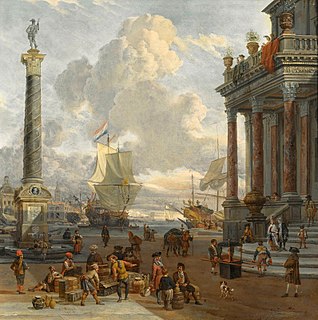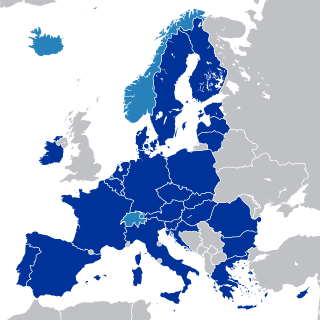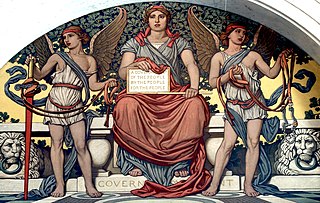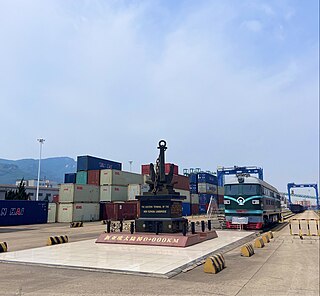 W
WEconomic integration is the unification of economic policies between different states, through the partial or full abolition of tariff and non-tariff restrictions on trade.
 W
WComplete economic integration is the final stage of economic integration. After complete economic integration, the integrated units have no or negligible control of economic policy, including full monetary union and complete or near-complete fiscal policy harmonisation.
 W
WA currency union is an intergovernmental agreement that involves two or more states sharing the same currency. These states may not necessarily have any further integration.
 W
WA customs union is generally defined as a type of trade bloc which is composed of a free trade area with a common external tariff.
 W
WAn economic and monetary union (EMU) is a type of trade bloc that features a combination of a common market, customs union, and monetary union. Established via a trade pact, an EMU constitutes the sixth of seven stages in the process of economic integration. An EMU agreement usually combines a customs union with a common market. A typical EMU establishes free trade and a common external tariff throughout its jurisdiction. It is also designed to protect freedom in the movement of goods, services, and people. This arrangement is distinct from a monetary union, which does not usually involve a common market. As with the economic and monetary union established among the 27 member states of the European Union (EU), an EMU may affect different parts of its jurisdiction in different ways. Some areas are subject to separate customs regulations from other areas subject to the EMU. These various arrangements may be established in a formal agreement, or they may exist on a de facto basis. For example, not all EU member states use the Euro established by its currency union, and not all EU member states are part of the Schengen Area. Some EU members participate in both unions, and some in neither.
 W
WAn economic partnership agreement is an economic arrangement that eliminates barriers to the free movement of goods, services, and investment between countries. This agreement can be considered an intermediate step between free trade area and single market in the process of economic integration. Economic partnerships are sometimes described as high standard variants of free trade agreements.
 W
WAn economic union is a type of trade bloc which is composed of a common market with a customs union. The participant countries have both common policies on product regulation, freedom of movement of goods, services and the factors of production and a common external trade policy. When an economic union involves unifying currency it becomes an economic and monetary union.
 W
WThe Eurasian Land Bridge, sometimes called the New Silk Road, is the rail transport route for moving freight and passengers overland between Pacific seaports in the Russian Far East and China and seaports in Europe. The route, a transcontinental railroad and rail land bridge, currently comprises the Trans-Siberian Railway, which runs through Russia and is sometimes called the Northern East-West Corridor, and the New Eurasian Land Bridge or Second Eurasian Continental Bridge, running through China and Kazakhstan. As of November 2007, about one percent of the $600 billion in goods shipped from Asia to Europe each year were delivered by inland transport routes.
 W
WThe European Single Market, Internal Market or Common Market is a single market comprising the 27 member states of the European Union (EU) as well as – with certain exceptions – Iceland, Liechtenstein, and Norway through the Agreement on the European Economic Area, and Switzerland through bilateral treaties. The single market seeks to guarantee the free movement of goods, capital, services, and people, known collectively as the "four freedoms".
 W
WFiscal union is the integration of the fiscal policy of nations or states. Under fiscal union decisions about the collection and expenditure of taxes are taken by common institutions, shared by the participating governments. A fiscal union does not imply the centralisation of spending and tax decisions at the supranational level. Centralisation of these decisions would open up not only the possibility of inherent risk sharing through the supranational tax and transfer system but also economic stabilisation through debt management at the supranational level. Proper management would reduce the effects of asymmetric shocks that would be shared both with other countries and with future generations. Fiscal union also implies that the debt would be financed not by individual countries but by a common bond.
 W
WA free-trade area is the region encompassing a trade bloc whose member countries have signed a free trade agreement (FTA). Such agreements involve cooperation between at least two countries to reduce trade barriers, import quotas and tariffs, and to increase trade of goods and services with each other. If natural persons are also free to move between the countries, in addition to a free-trade agreement, it would also be considered an open border. It can be considered the second stage of economic integration.
 W
WThe Grand Free Trade Area (GFTA) is a project envisaged by several regional blocs in Africa in order to bring about increased intra-African trade.
 W
WThe Cooperation Council for the Arab States of the Gulf, originally known as the Gulf Cooperation Council, is a regional, intergovernmental political and economic union that consists of Bahrain, Kuwait, Oman, Qatar, Saudi Arabia, and the United Arab Emirates. The council's main headquarter is in the city of Riyadh in Saudi Arabia. The Charter of the GCC was signed on 25 May 1981, formally establishing the institution.
 W
WThe International North–South Transport Corridor (INSTC) is a 7,200-km-long multi-mode network of ship, rail, and road route for moving freight between India, Iran, Afghanistan, Azerbaijan, Russia, Central Asia and Europe. The route primarily involves moving freight from India, Iran, Azerbaijan and Russia via ship, rail and road. The objective of the corridor is to increase trade connectivity between major cities such as Mumbai, Moscow, Tehran, Baku, Bandar Abbas, Astrakhan, Bandar Anzali, etc. Dry runs of two routes were conducted in 2014, the first was Mumbai to Baku via Bandar Abbas and the second was Mumbai to Astrakhan via Bandar Abbas, Tehran and Bandar Anzali. The objective of the study was to identify and address key bottlenecks. The results showed transport costs were reduced by "$2,500 per 15 tons of cargo". Other routes under consideration include via Kazakhstan and Turkmenistan.
 W
WAn investment policy is any government regulation or law that encourages or discourages foreign investment in the local economy, e.g. currency exchange limits.
 W
WPolicies advocating Middle East economic integration aim to bring about peace, stability, and prosperity in the Middle East, which they believe can only be sustained over the long run via regional economic cooperation.
 W
WThe China-Indochina Peninsula economic corridor (CICPEC) is an economic corridor initiated in 2010 and incorporated later into the Belt and Road Initiative. It was known before as the Nanning-Singapore Economic Corridor.
 W
WThe New Eurasian Land Bridge, also called the Second or New Eurasian Continental Bridge, is the southern counterpart to the Eurasian Land Bridge and runs through China and Central Asia with possible plans for expansion into South and West Asia. The Eurasian Land Bridge system is important as an overland rail link between China and Europe, with transit between the two via Central Asia and Russia.
 W
WA preferential trade area is a trading bloc that gives preferential access to certain products from the participating countries. This is done by reducing tariffs but not by abolishing them completely. It is the first stage of economic integration.
 W
WRegional Integration is a process in which neighboring countries enter into an agreement in order to upgrade cooperation through common institutions and rules. The objectives of the agreement could range from economic to political to environmental, although it has typically taken the form of a political economy initiative where commercial interests are the focus for achieving broader socio-political and security objectives, as defined by national governments. Regional integration has been organized either via supranational institutional structures or through intergovernmental decision-making, or a combination of both.
 W
WA single market is a type of trade bloc in which most trade barriers have been removed with some common policies on product regulation, and freedom of movement of the factors of production and of enterprise and services. The goal is that the movement of capital, labour, goods, and services between the members is as easy as within them. The physical (borders), technical (standards) and fiscal (taxes) barriers among the member states are removed to the maximum extent possible. These barriers obstruct the freedom of movement of the four factors of production.
 W
WIn international finance, a world currency, supranational currency, or global currency is a currency that would be transacted internationally, with no set borders.